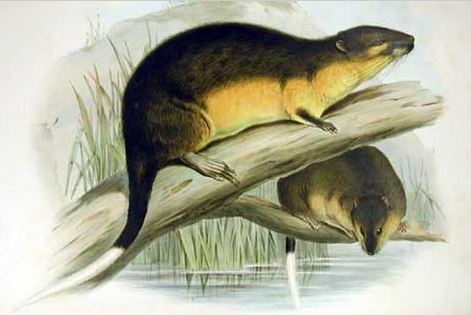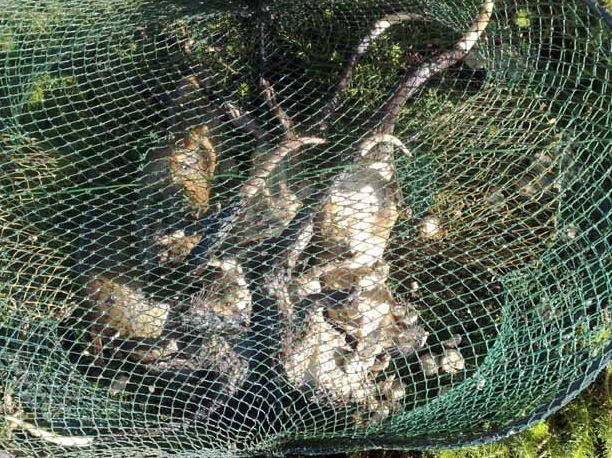
CREDITS : © J Gould © Victoria Museum, http://www.museum.vic.gov.au
Recently whilst pottering around in the backyard I saw what I first thought was a ringtail possum in the undergrowth. That was until it scampered across the open yard at a pace a ringtail could only dream of attaining on the ground. It was the biggest rat I had ever seen and it seems to have taken up residence in the ponds (i.e. bathtubs and containers I have set-up for fish and frogs) in my yard.
Since then I have seen it regularly and it doesn’t look like the rats I usually see in the urban environment; it was huge at around 1.5 kg and it also had a fluffy tail tipped with white and a slightly golden underbelly. I’ve seen these guys before when fishing so after the first good look at it I knew it was a native water rat (also known as the rakali). That’s where my knowledge on the species ended.
After a bit of a dig around, I feel like I have a basic understanding of the species. The rakali is a semi aquatic native rodent and the scientific name (Hydromys chrysogaster) means golden-bellied water mouse. The species fulfils a role similar to that of an European otter and doesn’t carry the nasties associated with our invasive rat species (diseases, parasites etc.). Most Australians are unaware of the rakali or mistake it for a black rat and treat it in a similar manner. The rakali has been trapped, poisoned and killed throughout its range, often in the mistaken belief that it is a huge black rat.

The rakali is also often caught unintentionally in traps and nets like these five killed in a single crab trap at cherry pools in Victoria. The trap owner didn’t seem to be particularly concerned.
The persecution of the rakali is a shame and seems to be counter-productive if the intention is to rid the area of disease carrying rats. Professor Peter Banks, a rakali researcher at Sydney uni says high numbers of rakali seem to result in low numbers of the invasive black rat. That sounds like a good thing to me. I’ve also seen lots of claims that this animal is one of the few native predators of the cane toad and there seems to be anecdotal evidence at least, that this is true. So next time you see a huge rat, take a second look! You might be lucky enough to be seeing the rakali.
If you are interested in finding out more about this interesting native than it is worth taking a look at the embedded radio national interview of rakali researcher Professor Peter Banks (you can find the full interview here) and also taking a look at the citizen science project below.

Rakali (water rat) The image has been provided as part of the Rakali Community Survey © Tracy Oliver . This new citizen science project is designed to improve knowledge of this elusive native rodent whose current distribution, habitat needs and threats are poorly known. As a top-order predator, rakali may be useful indicators of healthy waterways, and this project will also aim to influence better management of rivers and wetlands in Western Australia.
WWF-Australia and the WA Department of Parks and Wildlife are conducting a Rakali Community Survey at present. If you have seen a rakali in Western Australia please go here to find out more about the project and how you can be of assistance. Any sightings in the Eastern states can be directed to the Australian Platypus Conservancy (http://www.platypus.asn.au/ )

Cool! There’s a few scampering around up here on Lizard Island.
LikeLike
Marty …All I see in that comment is Lizard Island and then the jealousy sets in 😉
LikeLiked by 1 person
Fascinating. I’ve seen glimpses of them in the river. We’re putting out some cameras so maybe we’ll get some sightings.
LikeLike
Thanks :). Let us know how you go with the cameras! It will be interesting to see what shows up. That reminds me, I’ll have to set up a camera trap in my yard sometime.
LikeLike
Thanks for this! I have wished for a long-time that we could get rid of the word ‘rat’ in their common name! Love seeing them on the River Murray system 🙂 Once spent half an hour with, a fellow aquatic science colleague, watching one play, after we had finished our ‘real’ work of course!! 🙂
LikeLiked by 1 person
Thanks for the feedback. The name change is not a bad idea actually, that would be a good start I think. My own personal pet ‘name change’ number one is basically for the opposite reasons (to use the common name plague minnow instead of mosquito fish). I think I am one of the only people who refers to the little blighters as plague minnows haha
LikeLike
This is a great post. Long live the Rakali. We supposedly had them in the hammered creek that runs through the middle of our town, but given that all vegetation has recently been replaced with concrete they may not have survived. You’ve inspired me to trek downstream a bit though and search for evidence of them. Another small urban natural history mystery to tackle! Cheers.
LikeLiked by 1 person
Thanks Robert. Would be a shame if they were gone. Let me know how you go, id be interested to know if they manage to survive in a devegetated environment or if the introduced species do better.
LikeLike
Thanks – fascinating! We live at about 200 metres but not too far as the crow flies from Berowra Creek, part of the Hawksbury Estuary. When we arrived here we found a skull that we think was a water rat of some kind. How far would a rakali travel from water?
LikeLike
Thanks for the feed back :). I don’t know for sure but I’d say they would travel that far from water on occasion. My yard is nowhere near any real permanent water bodies and one has turned up here. There are a few creeks within perhaps 300-500m but they dont always hold water but I suspect they are using drains etc as well where is possible permanent water I don’t know about.
LikeLike
Nice post! Well Queensland hasn’t always been known for its environmental wisdom, but we do have a sculpture of a water rat (it’s known as Kurilpa up here), counselling an elephant standing on its head, pride-of-place, in front of the Gallery of Modern Art. The real thing hangs out nearby (water rats, not elephants), playing with the water dragons along the Brisbane River.
LikeLiked by 1 person
Pingback: Fish Thinkers online: 2015 in review | fish thinkers
Reblogged this on lachlanfetterplace and commented:
A blog from the past that unexpectedly got quite a lot of attention.
LikeLike